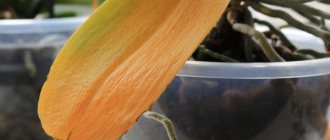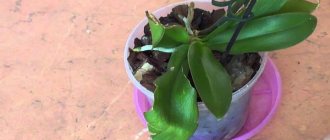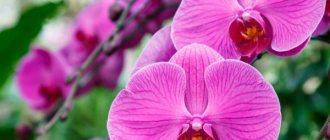A profusely flowering plant with lush green foliage is a real pride for any orchid grower. But maintaining a “pet” in this state all the time is not an easy task. Flowers are famous for being sensitive to any mistakes in care. A common problem that their owners have to face is when the leaves of an orchid turn black.
What is it and what does it look like?
Blackening of orchid leaves occurs in different ways. Everything will depend on what reason led to this condition. The leaf turns black completely or partially. Additional signs include:
- Necrotic changes throughout the entire leaf blade or part thereof.
- The spots vary in size and color (from brown to gray).
- The spots quickly darken and have a watery content.
- The leaves may turn black at their base, which leads to their subsequent falling off.
- The surface of the leaf becomes covered with a black coating, while losing its elasticity and becoming loose.
- The surface of the leaf may be brown, and then black dots appear on it.
- The veins and tips of the leaves turn black.
- First, black dots of various sizes appear, which eventually merge into one spot.
Most often, all these signs are accompanied by a stop in the growth of orchids and their lack of flowering. Therefore, you should always inspect your favorite plant and, in case of suspicious manifestations, immediately begin resuscitating the flower.
Important! If the orchid leaves become damp and show signs of rotting, this means that the painful process has already affected the roots of the plant. Therefore, in this case, you need to start treatment with the flower’s horse system.
You can learn more about the types, causes and prevention of depigmentation of leaves, flowers and roots of orchids in this article.
Treatment methods
So what should you do if you find black spots or spots on your pet's leaves? To avoid infection of other flowers and to rid the diseased plant of alarming symptoms as quickly as possible, it is recommended to proceed as follows:
- Isolate the orchid and try to find out the cause of the defects. This way you can avoid infecting other flowers.
- Cut off the flower stalk. Even if you have been waiting for the moment of flowering for a very long time, do not be cowardly. During such a period, the flower needs strength to fight the disease and recover. After recovery, the plant will definitely delight you with succulent leaves and a new inflorescence.
- If pests are found on the orchid, remove them mechanically. For these purposes, you can wash the leaf plates with soapy water, wipe them with a soft, dry cloth, and then treat them with a special disinfectant composition (Trichopol, Fundazol).
- If fungal manifestations are detected, it is recommended to stop watering and spraying for the period of treatment and provide the orchid with a comfortable temperature. Once every 10 days, it is necessary to treat the leaves with copper-containing solutions (1% solution of copper sulfate or copper oxychloride).
Important! It is possible to save the leaf blade from painful manifestations only when symptoms are first detected. If black spots have managed to affect certain areas of the leaf, they must be cut off and sprinkled with crushed activated carbon along the cut line.
To save an orchid from blackening of the leaves, be sure to ask when purchasing which species it belongs to, and try to comply with the maintenance conditions prescribed only for this type of plant.
Now you know what to do if you find black spots or dots on the leaf blades of your orchid!
What is it a sign of?
As a rule, the leaves of a home orchid turn black due to errors in care. But if the grower does everything according to the rules, then the cause may be various diseases.
Read more about what leaf diseases occur in orchids, what their symptoms look like in the photo, and why you shouldn’t delay treatment here.
Septoria
The disease is caused by Septoriaselenophomoides microorganisms. First, wet dark spots appear on the leaves, which then dry out and leave behind blackening. Over time, they turn yellow and merge into a single large spot. After all these processes, the leaves begin to fall off. The following types of orchids are most often susceptible to this disease: Cymbidiums, Oncidiums, Cattleyas.
Spot (black or bacterial)
The disease develops due to viruses, resulting in dark or black dots (sometimes lines) appearing on the leaves. The disease is considered contagious and spreads quickly. Therefore, damaged leaves are immediately removed so that the virus does not penetrate the root system.
Mosaic
This is also a viral disease that most Cymbidiums suffer from. Dark spots first appear on the leaves, in place of which a hole then forms. Mosaic develops against the background of mechanical damage to the flower. The carriers are insects.
Fusarium
The causative agents of the disease are fungi from the genus Fusarium. First, black bubble spots form on the leaf, then the leaves begin to crumble and fall off. The disease can occur due to excessive moisture, hypothermia or soil salinity.
Why is this happening?
In addition to diseases, there are many reasons for blackening of orchids, ranging from improper watering to infections. The leaves turn black completely or partially due to errors in care or the following errors in creating the conditions for keeping orchids:
- If the air in the room is too dry or, on the contrary, humid.
- Frequent or infrequent watering that does not correspond to a certain season (how to save an orchid damaged by the flood?).
- If there is high air temperature, most often it is +30 and above.
- Low temperatures also negatively affect the flower. Temperatures from +18 and below can damage it.
- If the flower has been damaged by a mite. Usually, such damage on leaves can be detected immediately.
If you place a pot with an orchid in close proximity to a heater, the result can be a thermal burn. Such spots on the leaves are brown or black with multi-colored edging. A heat burn looks the same as a sunburn. These are usually dark spots with a yellow outline.
Chlorosis in the photo
Yellowing plant leaves may be a result of chlorosis infection. The disease is divided into infectious and non-infectious.
Infectious chlorosis is accompanied by the appearance of spots and tubercles. The cause of infection can be viruses, bacteria, fungi or parasites. Treated with antifungal drugs.
A non-infectious disease occurs due to micronutrient deficiency or poor lighting. In this case, it is necessary to create comfortable conditions for the flower and add fertilizer to the soil.
Consequences for flowers
If you do not stop the process of blackening of the orchid at an early stage, the plant may die. Over time, this circumstance leads to rotting of the flower. Black dots spread to the flowers themselves and the stem. What to do if the trunk, roots and leaves of a flower turn black? If this happens in the later stages of the disease, then all resuscitation actions are pointless (read more about how to save an orchid without roots, and from this article you will learn how to resuscitate a flower if the root system and leaves are missing).
What to do: step-by-step instructions
If blackheads appear
They may indicate a viral, fungal or bacterial infection in the plant. The most common disease is black spot. To save an orchid, you must take the following steps:
- Isolation of a sick flower.
- Removing damaged areas.
- Disinfection of sections with an antiseptic solution.
- Treating the plant with a fungicide solution or its analogues.
The leaves or their tips have turned black
The reason for this condition of the leaves most often lies in improper care. For example, the presence of drafts in the room, dry air, hypothermia or overfeeding with fertilizers have a negative effect on the flower. Resuscitation measures:
- Restoring normal temperature and humidity in the room.
- Damaged leaves should be cut off.
- Place the orchid in a room where there are no drafts, but there is good ventilation.
- Reducing mineral fertilizers.
Reference. In order for the orchid not to get sick and to bloom, it is necessary to create conditions for it that are as close to natural as possible.
The roots have darkened
Aerial roots often turn black. Let's look at why this happens to the roots, because their treatment will depend on the cause of the blackening. For example, if a root burn occurs, the flower can no longer be restored. If the cause is increased accumulation of salts in the soil, then the orchid can be helped in this case:
- The flower is first washed in running water for 5-10 minutes.
- Areas with damage in the root area are removed.
- The cut area is treated with crushed activated carbon.
- If necessary, the soil is completely replaced.
When the treatment of the orchid is completed, it is left in quarantine for at least 2 weeks.
Sticky sweet drops
Sticky sweet drops do not always indicate an orchid disease. The flower may secrete nectar to attract insects for pollination.
In the case of a flower disease, sticky formations may arise from excessive moisture. The flower thus gets rid of excess moisture.
The appearance of spots can also be a defense mechanism against pests or protection from burns from direct sun rays.
Preventing the return of the disease
To prevent the disease from returning again, it is necessary to follow preventive measures. They consist in proper care of the plant:
- The potting substrate should not be cooled. Therefore, it is necessary to control the air temperature in the room, do not place the pot on a cold windowsill and ensure that the moisture does not evaporate quickly.
- The frequency of watering should depend on the level of illumination of the flower: the brighter the light, the more often the orchid needs to be watered. Most flowers of this species are epiphytes. This means that their aerial roots can receive moisture from the air. It is necessary to ensure that there is no stagnation of water in the pot, that there are no drafts, but that there is regular ventilation.
- A low-quality substrate can lead to the death of the plant, so this must be monitored with special care. Thus, the presence of peat and polystyrene foam in the soil should not exceed 20%. Otherwise, when trying to destroy painful microorganisms, beneficial bacteria may die along with them, since peat and polystyrene in large quantities have a destructive effect.
It should be remembered that the better the plant’s immunity, the less susceptible it is to various diseases. And this depends entirely on proper care. If optimal conditions are created for growing orchids, then they will not be afraid of diseases.
Plant care
Avoiding such unpleasant situations is possible only with proper care of the orchid:
- Maintaining a comfortable temperature in summer: +22-25ºС, in winter +16-18ºС. The difference in temperature differences should not exceed 5ºС.
- Lighting is required diffused, with a daylight duration of 14 hours. In the summer, intense sunlight needs to be shaded.
- Humidity within 50-60%. Be sure to regularly ventilate the room.
- Choose a proven, high-quality substrate.
- Water once a week with warm, soft water. In between, the soil should dry out completely.
- Orchids need to be fertilized 2 times a month, especially during the flowering period. Use fertilizers with a predominant content of potassium and iron.
- It is better to spray phalaenopsis up to 5 times a day. Avoid the procedure during the flowering period. Be sure to ensure that water does not stagnate in the axils of the flower.











